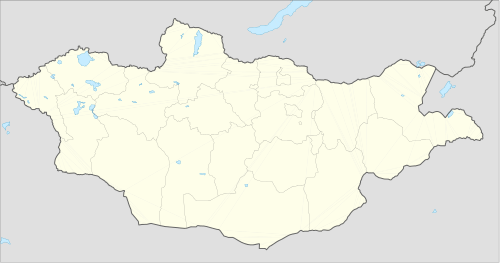Choijin Lama Temple
| Choijin Lama Temple Чойжин ламын сүм | |
|---|---|
 Choijin Lama Temple, Ulaanbaatar, Mongolia | |
 Choijin Lama Temple Location within Mongolia | |
| Coordinates | 47°54′54″N 106°55′06″E / 47.91500°N 106.91833°E |
| Monastery information | |
| Location | Ulaanbaatar, Mongolia |
| Founded | 1904 |
| Type | Tibetan Buddhist |
| Architecture | Chinese, Mongol and Tibetan influences |
The Choijin Lama Temple (Mongolian: Чойжин ламын сүм) is a Buddhist monastery in Ulaanbaatar, the capital of Mongolia.
The complex consists of four temples originally occupied by the brother of the ruler Bogd Khan, Choijin Lama Luvsankhaidav, who was the state oracle at the time. The complex was begun in 1904 and completed in 1908, in honor of the Lama Lubsanhaidub, brother of the eighth Bogd Khan.[1] The Choijin Lama Museum was originally a Buddhist temple complex, consisting of one main and five branch temples.[2] It was active until 1937, when it was closed during the height of Communist repression against Buddhism and other religious traditions.[3] In 1938 the Stalinist government converted the complex into a museum.
The main temple features an 18th-century gilt statue of Buddha Sakyamuni with a statue of Choijin Lama Luvsankhaidav on the Buddha's right and the embalmed corpse of Baldanchoimbolon on his left. In addition, the temple boasts a copious collection of religious instruments, thangka paintings, a copy of the 108-volume Kangyur and hand-printed 226-volume Tengyur brought from Tibet by the Bogd Khan, and a collection of cham dance masks).
The annex to the temple contains a heated ger and a central square in which Choijin Lama Luvsankhaidav performed rituals.
The Zuu Temple, dedicated to the Buddha Shakyamuni features papier-mache sculptures of Buddha in the past, present, and future. The 16 disciples of Buddha appear on the temple walls with four Maharantsa protectors shown sitting in caves on either side of the door.
The Yidam Temple was used as a place of prayer by Choijin Lama Luvsankhaidav, and therefore closed to the public. In its center is a gilt bronze sculpture of one of the 84 Indian yogis, or Mahasiddha. Also depicted are the tantric gods Kalacakra, Mahamaya, Vajradhara and others with their shakti or consorts in postures of meditation that symbolize power and strength.
The fourth temple, the temple of amugulang or peace, is dedicated to the first Mongolian reincarnation of Boghda Jevzundamba, Undur Gegeen Zanabazar, (1635-1724).[4]
- Choijin Lama Temple
 Choijin Lama Temple
Choijin Lama Temple- One of the prayer halls is in the shape of a ger
 Richly decorated roof on one of the halls
Richly decorated roof on one of the halls Stone lions and beasts protect the temple
Stone lions and beasts protect the temple
Museum
The museum, it preserves a rich heritage of Buddhist artifacts. Located in central Ulaanbaatar directly south of Sukhbaatar square, the museum is open year-round (with reduced hours during the winter months). Explanations of the almost overwhelming collection are not as detailed as they could be, but each temple has room attendants who can provide additional material. The museum itself and its objects also show the re-emergence of Buddhism in Mongolia after Communist repression, with a particularly interesting display on Buddhist tsam dancing and its modern revival.[5]
References
External links
![]() Media related to Choijin Lama Temple at Wikimedia Commons
Media related to Choijin Lama Temple at Wikimedia Commons